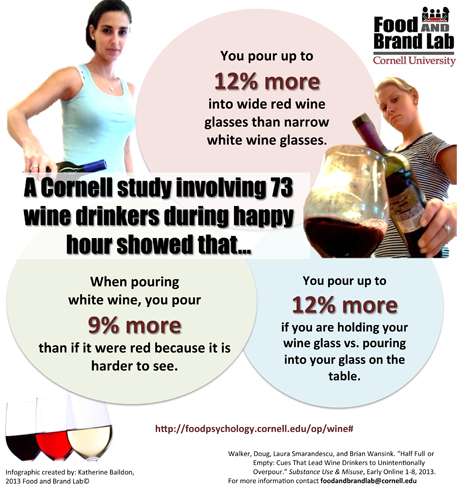Size, shape and color of wine glass affect your pouring

While most people think of a glass of wine as one serving, it could be closer to two or three. How much one pours is influenced by such environmental factors as the size, shape and color of the wine glass, researchers at Iowa State and Cornell universities report, and that could have serious consequences when it comes to overconsumption.
In the study, published in Substance Use and Misuse, participants were asked to pour what they considered a normal drink using different types of glasses in various settings. Participants poured about 12 percent more wine into a wide glass than a standard one. The same was true when holding a glass while pouring compared with placing the glass on a table.
“People have trouble assessing volumes,” said lead author Laura Smarandescu, an assistant professor of marketing at Iowa State, who worked in collaboration with Brian Wansink, director of the Food and Brand Lab at Cornell. “They tend to focus more on the vertical than the horizontal measures. That’s why people tend to drink less when they drink from a narrow glass, because they think they’re drinking more.”
Researchers tested six environmental cues to understand how each influenced the amount poured. The contrast between the glass and color of the wine also made a significant difference. For example, when pouring white wine into a clear glass, participants poured 9 percent more than when pouring red, which had a greater contrast to the glass. The influence of a small and large table setting was not as strong.
Wine is different from alcoholic drinks that are served in a bottle or measured with a shot glass, making it easy for individuals to over pour. A standard serving of wine is five ounces, according to the National Institute on Alcohol Abuse and Alcoholism. But co-author Douglas Walker, an assistant professor of marketing at Iowa State, said it’s easy to lose track of how many drinks you’ve had, if you are pouring more than you realize.
“If you ask someone how much they drink and they report it in a number of servings, for a self-pour that’s just not telling the whole story. One person’s two is totally different than another person’s two,” Walker said. “Participants in the study were asked to pour the same amount at each setting, but they just couldn’t tell the difference.”
“If you want to pour and drink less wine, stick to the red wine glasses and only pour if your glass is on the table or counter and not in your hand – in either case you’ll pour about 9-12 percent less,” Wansink said.
Unlike eating too much, there are more immediate and serious consequences associated with drinking too much. Smarandescu said people will often rely on internal cues, such as a full feeling, when eating, but that doesn’t work with drinking. The study demonstrates the need to educate people about how to measure a proper serving size of alcoholic drinks, she said.
“The fact they were able to know retrospectively, but they still poured different amounts, told us they didn’t think about it when pouring otherwise they would have adjusted. So they had to be prompted to think about how much they poured,” Walker said.
Researchers add that even though participants could identify those environmental factors, it does not suggest they knew how much more they were pouring to accurately track their alcohol intake.
The Cornell Food and Brand Lab funded the study.
Media Contact
Get Cornell news delivered right to your inbox.
Subscribe